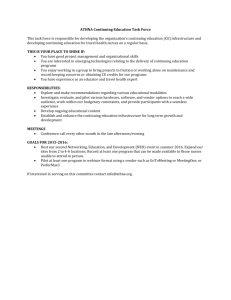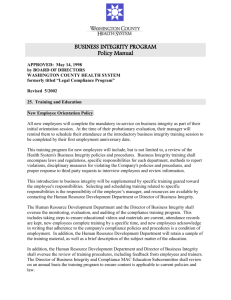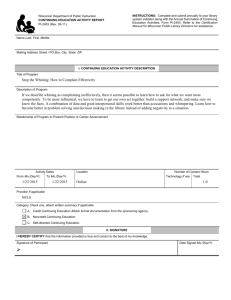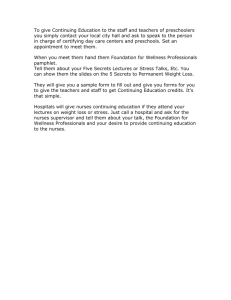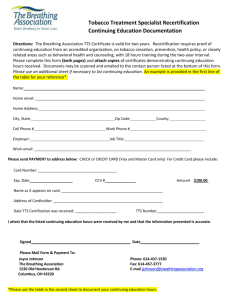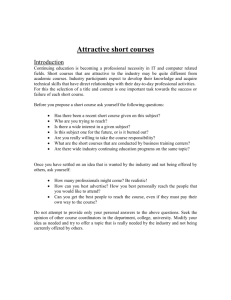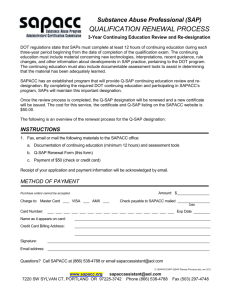President's Corner International Association for Continuing
advertisement
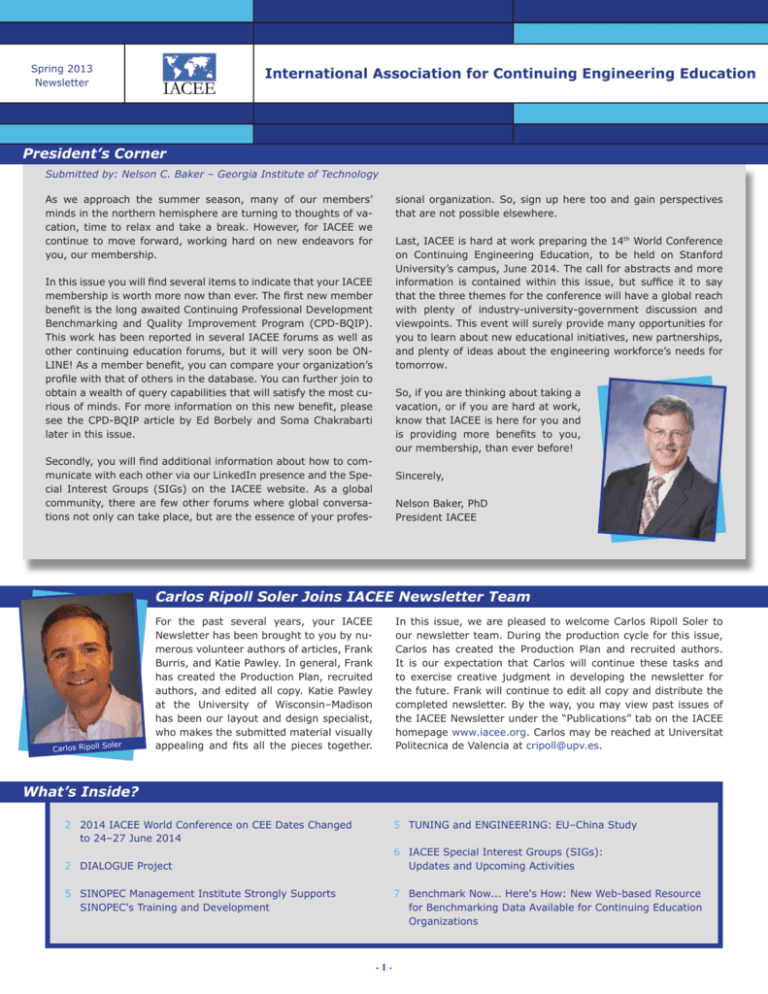
Spring 2013 Newsletter International Association for Continuing Engineering Education President’s Corner Submitted by: Nelson C. Baker – Georgia Institute of Technology As we approach the summer season, many of our members’ minds in the northern hemisphere are turning to thoughts of vacation, time to relax and take a break. However, for IACEE we continue to move forward, working hard on new endeavors for you, our membership. sional organization. So, sign up here too and gain perspectives that are not possible elsewhere. Last, IACEE is hard at work preparing the 14th World Conference on Continuing Engineering Education, to be held on Stanford University’s campus, June 2014. The call for abstracts and more information is contained within this issue, but suffice it to say that the three themes for the conference will have a global reach with plenty of industry-university-government discussion and viewpoints. This event will surely provide many opportunities for you to learn about new educational initiatives, new partnerships, and plenty of ideas about the engineering workforce’s needs for tomorrow. In this issue you will find several items to indicate that your IACEE membership is worth more now than ever. The first new member benefit is the long awaited Continuing Professional Development Benchmarking and Quality Improvement Program (CPD-BQIP). This work has been reported in several IACEE forums as well as other continuing education forums, but it will very soon be ONLINE! As a member benefit, you can compare your organization’s profile with that of others in the database. You can further join to obtain a wealth of query capabilities that will satisfy the most curious of minds. For more information on this new benefit, please see the CPD-BQIP article by Ed Borbely and Soma Chakrabarti later in this issue. So, if you are thinking about taking a vacation, or if you are hard at work, know that IACEE is here for you and is providing more benefits to you, our membership, than ever before! Secondly, you will find additional information about how to communicate with each other via our LinkedIn presence and the Special Interest Groups (SIGs) on the IACEE website. As a global community, there are few other forums where global conversations not only can take place, but are the essence of your profes- Sincerely, Nelson Baker, PhD President IACEE Carlos Ripoll Soler Joins IACEE Newsletter Team ler Carlos Ripoll So For the past several years, your IACEE Newsletter has been brought to you by numerous volunteer authors of articles, Frank Burris, and Katie Pawley. In general, Frank has created the Production Plan, recruited authors, and edited all copy. Katie Pawley at the University of Wisconsin–Madison has been our layout and design specialist, who makes the submitted material visually appealing and fits all the pieces together. In this issue, we are pleased to welcome Carlos Ripoll Soler to our newsletter team. During the production cycle for this issue, Carlos has created the Production Plan and recruited authors. It is our expectation that Carlos will continue these tasks and to exercise creative judgment in developing the newsletter for the future. Frank will continue to edit all copy and distribute the completed newsletter. By the way, you may view past issues of the IACEE Newsletter under the “Publications” tab on the IACEE homepage www.iacee.org. Carlos may be reached at Universitat Politecnica de Valencia at cripoll@upv.es. What’s Inside? 2 2014 IACEE World Conference on CEE Dates Changed to 24–27 June 2014 5 TUNING and ENGINEERING: EU–China Study 6 IACEE Special Interest Groups (SIGs): Updates and Upcoming Activities 2 DIALOGUE Project 5 SINOPEC Management Institute Strongly Supports SINOPEC's Training and Development 7 Benchmark Now... Here's How: New Web-based Resource for Benchmarking Data Available for Continuing Education Organizations -1- 2014 IACEE World Conference on CEE Dates Changed to 24–27 June 2014 Submitted by: Robert Katayama and Paul Marca – Stanford University Abstracts Due 27 Se ptembe r 2013 case studies and best practices, we will share the challenges in developing and maintaining successful industry-academia partnerships, explore the hallmarks of such multi-organizational collaborations, and discover how these relationships maintain their dynamism and effectiveness. Help us build and change the way we educate. Present your paper on one of the following conference tracks at the IACEE 14th World Conference on Continuing Engineering Education at Stanford University, 24–27 June 2014. Submit a 100 to 150 word abstract for consideration by 27 September 2013: http:// iacee2014.stanford.edu/courses/call-for-papers.php Get more information on these tracks and submit your abstract for consideration today: http://iacee2014.stanford.edu/courses/ call-for-papers.php Conference Tracks: Global Workforce of Tomorrow–The increasingly diverse and distributed global workforce is changing the way engineers view education and interact with providers. Today's engineers need to commit to lifelong learning to succeed in a changing global economy and in work environments that are becoming more virtual and cross-cultural. New generation learners present additional challenges to the way education needs to be delivered. Don’t forget to get connected and join the conversation on the IACEE 14th World Conference on Continuing Engineering Education: • Keep up-to-date with conference happenings by following the official Twitter account @IACEE2014 or by checking out the website at http://iacee2014.stanford.edu. Innovation in Education–Innovation means that CEE is anything but business as usual. The landscape of continuing engineering education is rapidly being transformed by innovations in teaching and learning technology, changing student expectations and demands, and novel educational models. Massively Open Online Courses (MOOCs), flipped classrooms, and blended/hybrid learning models are changing the traditional classroom experience. • To be added to the conference email list, submit your contact information at: http://iacee2014.stanford.edu/submit-inquiry.php • Start networking with fellow conference goers in the conference’s LinkedIn group at: http://goo.gl/xXpF7 Industry and University Collaboration–Continuing engineering education creates a bridge between academia and industry. Through DIALOGUE Project Submitted by: Alfredo Soeiro – University of Porto The network has four thematic groups: (1) Access and Progression, (2) Learning and Guidance, (3) Quality, and (4) New Media. The consortium has 16 partners from which 14 belong to two of the thematic groups. Each member of each thematic group has produced a case study about the theme. Each partner has written a national report about the good practices, national policies, and activities in lifelong Alfredo Soeiro learning. DIALOGUE has a website where public information is available (http://dialogue.eucen.eu/). The project will present the final results at a seminar in Brussels, Belgium on 15 October 2013. All are invited to participate in the seminar and/or to cooperate with the project Dialogue. Take a look at the project recommendations for a fruitful discussion. DIALOGUE is a project coordinated by EUCEN (European University Continuing Education Network) and is financed by the European Commission under the program Grundtvig. This initiative aims to create a network that connects lifelong learning providers and researchers with relevant society stakeholders. This network addresses the particular aspect of the communication process between academic research and professional practice in the field of adult learning and continuing education. It is an area that needs serious research to improve the quality of the process. The current processes of communication are underdeveloped. Therefore, there is little potential through this exchange for the enhancement and further development of effective University Lifelong Learning (ULLL). A stronger relationship between the research, the policy, and the practice could contribute to solving this problem. -2- IACEE Financial Report Through 30 April 2013 Submitted by: Frank Burris – IACEE Headquarters As of 30 April, one-third of our IACEE fiscal year has passed. The following table portrays our Income, Expense, and Net and a comparison against our 2013 Budget after four months. Only line items where there have been non-zero Income and Expense are shown below. Income/Expense $ FY 2013 Budget Year-to-Date Actual Balance Forward on 1 January 2013 $42,392.88 $42,392.88 Institutional Dues (Types 1, 2, 3, & 4) $15,000.00 $3,268.00 Individual Dues (Type 5) $5,200.00 $1,065.00 Quality Program Subscriptions $5,000.00 $4,500.00 $160.00 $50.83 $67,752.88 $51,276.71 ($600.00) ($200.00) ($1,190.00) ($431.29) Interest on Savings Account TOTAL INCOME Vieth Consulting Monthly Fees Wells Fargo Bank & PayPal Fees Staff Travel Staff Compensation Meetings Quality Program TOTAL EXPENSE NET ($7,500.00) ($1,583.68) ($12,480.00) ($3,000.00) ($2,000.00) ($257.46) ($5,000.00 ($3,363.75) ($28,770.00) ($8,836.18) $38,982.88 $42,440.53 Frank Burris As always, more detailed financial reports may be found as supporting documents for recent Council and Executive Committee meetings. Enter the File Archive section of Members’ Area of our website to locate these documents, or contact me at f.burris@iacee.org with your questions. Highlights of Annual IACEE Council Meeting, 15–16 May 2013 Submitted by: Frank Burris – IACEE Headquarters • A thorough review of the planning for the 2014 IACEE World The IACEE Council met on 15–16 May 2013 at the Baosteel Leadership Development Institute just outside Shanghai, China. A draft of the minutes of this council meeting was completed and sent to the IACEE Council on 19 May for additions and corrections. A revised set of minutes will be voted on in June. Upon approval, the minutes will be posted on the IACEE website and distributed to all IACEE members. Following is a bulleted list of some of the most significant events at this council meeting: Conference was presented by General Chair Paul Marca and Project Manager Robert Katayama, both of Stanford University. The Council acted to shift the Stanford World Conference dates from the previously announced March dates to 24–27 June 2014 to avoid a serious conflict in March. We now have two committed sponsors for the conference and continue to seek more. • Ten • The Council has spent much of the past nine months focused council members and two guests attended the meeting in person. Eight other council members participated by a Skype connection at some very strange times of the day and night! This is the first time that such a large portion of the council participated virtually, thereby creating IACEE’s version of the increasingly popular MOOC (Massively Open Online Council). on revisions to the IACEE Strategic Plan (SP) for 2013–2014. Each of the four new Strategic Goals have newly developed Critical Success Indicators, Strategies, and Actions. The achievement of these goals is being overseen by our four Vice Presidents: Goal 1: Products – VP Kim Scalzo Goal 2: Member Services: Engagement & Communication – VP Linda Krute Goal 3: Advancement of CEE – VP Zhang Guoqing Goal 4: Quality Assurance & Operational Excellence – VP Wim Van Petegem • Pat Hall provided a presentation tracing the significant prog- ress of IACEE’s CEE Manager Training Program. Included was the development of the concept of the “Knowledge Share Moment” (KSM) discussed elsewhere in this issue. Pat also discussed the development of a series of webinars for a CEEMTP certificate program. • The IACEE Quality Program has been renamed the Continu- • Soma Chakrabarti, SIG Coordinator, presented the activities/ ing Professional Development Benchmarking and Quality Improvement Program (CPD-BQIP) to make it more attractive to a broader continuing education audience, not just CEE. status of our current three active Special Interest Groups (Marketing, University-Industry Collaboration, and Innovations in CEE). continued on page 4 -3- new regions of the world. Nominations, including self-nominations, are invited from the membership. We have established a new website to access benchmarking data and hope to finalize the details of the program’s introduction to the membership during the coming summer. Watch for more information on this program in the very near future. • The planned 2–3 December 2013 Executive Committee meet- ing, in view of the World Conference’s dates’ shift, has been shifted back to 7–8 February 2014, in conjunction with the 2014 ASEE CIEC. The Conference Planning Committee (CPC) will be invited to participate in a conference walk-through at Stanford on the original 2–3 December 2013 dates. • A total of eight different membership and financial reports were reviewed by the council. • Eight of ten proposed bylaws revisions were approved by the council. Look for a letter soon containing the revised bylaws and announcing their posting on the IACEE website. The agenda and 30 other supporting documents for this council meeting are posted in the File Archive section of the Members’ Area of the IACEE website www.iacee.org. Interested members are encouraged to use their username and password to retrieve any or all of these documents. • The council reviewed a membership list to identify potential new candidates for the 2014–2016 council term from many Candidates for IACEE Council 2014–2016 Submitted by: Carlos Ripoll Soler – Universitat Politecnica de Valencia A new IACEE Council for the 2014–2016 biennium will be elected on 25 June 2014 at the 14th World Conference on CEE at Stanford University. Your association needs to have a strong slate of candidates for that Council election. If you wish to nominate candidates or to self-nominate, please declare your interest in Council service to Secretary General Frank Burris (f.burris@iacee.org) or to Past President Mervyn Jones (m.jones@imperial.ac.uk) as soon as possible. Council members are expected to demonstrate a strong interest in leadership in IACEE and to have at least the necessary resources available to support their participation at one annual Council meeting each year of their term. IACEE Membership Report Submitted by: Frank Burris – IACEE Headquarters Since publication of the Winter 2013 newsletter in February, IACEE has added no brand new members. However, last fall the rules on institutional memberships were changed to permit every institutional member to name up to four additional members on their membership record. To date, only 22 of our 57 institutional members have taken advantage of this offer by naming one to four additional members. Our current membership breakdown is shown in the table below, with member Types 1x, 2x, 3x, and 4x indicating the 56 additional members named by our 57 current institutional members (Types 1, 2, 3, and 4). Type 1: Regional Leader Organizations (RLO) 3 Type 1x: RLO additional members named 2 Type 2: Professional Organizations & Societies (PO&S) 3 Type 2x: PO&S additional members named 0 Type 3: Industrial Organizations & Companies (IO&C) 4 Type 3x: IO&C additional members named 10 Type 4: Academic Institutions and Other Coordinators & Providers of CEE (AI&OC&P) 47 Type 4x: AI&OC&P additional members named 44 Type 5: Individual Members 125 Total 238 Solicitation of Bids for World Conferences in 2016 and Beyond Submitted by: Carlos Ripoll Soler – Universitat Politecnica de Valencia The IACEE World Conferences on Continuing Engineering Education (WCCEE) are created BY and FOR continuing engineering education professionals. The 14th WCCEE will offer high-quality presentations, speakers, and events from all over the world at affordable rates in the heart of Silicon Valley at Stanford University. For faculty, executive leaders, academic directors and managers, IACEE provides a valuable professional development experience for all those who want to explore the unique issues facing continuing education for the engineering field. You can also be a major part of this activity by hosting one of the world conferences. The process to select candidates for world conferences in 2016 and beyond is now open. You can express your interest in being a host institution just by sending an email to IACEE President Nelson Baker (n.baker@iacee.org) or IACEE Secretary General Frank Burris (f.burris@iacee.org). Do not overlook this outstanding opportunity to showcase your company or institution by hosting the world! Thirty-five institutional members still have the opportunity to name their one to four additional members. Principal contacts for each of these 35 members may send the names and contact information to Frank Burris at f.burris@iacee.org. -4- SINOPEC Management Institute Strongly Supports SINOPEC's Training and Development Submitted by: Wang Caixia – SINOPEC countries share lectures on Chinese culture and SINOPEC’s core values, and have field trips to Chinese heritage sites and SINOPEC’s greatest refineries. Fu Chengyu, the SINOPEC Chairman, also meets them, which is a great honor for every SINOPEC employee. Thus, this seminar helps participants better understand Chinese legacies and get a detailed picture of what the parent company really looks like. SINOPEC Management Institute (SINOPECMI, www.sinopecmi.org), a training center with its location in Beijing, was built by the SINOPEC Group in 1987. It provides training programs for executives, international talents, and senior engineers. The annual number of participants on the SINOPECMI campus is around 12,000. Some of the currently stressed programs are: 1. Flexible Module Study Seven optional executive sessions including strategy management, risk management, effective leadership, decisionmaking management, supply chain management, strategic performance management, and accounting management are involved in this program. Each workshop lasts five days and participants can choose whatever module they desire. Feedback from 305 top managers demonstrates this design is more like an a la carte workshop, with flexibility for participants to customize their experience. 3. Distance Learning The distance learning center, set up by SINOPECMI, is one of the largest company virtual learning centers in China. It is quite common for SINOPEC employees to choose this virtual platform as an alternative when they cannot find the right time to sit in a real classroom. Distance learning is beneficial to employee training in many ways, such as flexible time and locations, which solves the conflicts between learning and working. At the end of 2012, more than 339,000 employees have registered on this platform and the learning time totals 4,410,000 hours. 2. Cross-cultural Communications Positioned as a strategic aid to SINOPEC‘s human resource development, SINOPECMI focuses on suggesting solutions to the challenges SINOPEC faces. With many oil blocks purchased overseas, one of SINOPEC’s challenges has been to send a large number of domestic senior engineers abroad to manage oil engineering projects. However its approaches are turning out to be less effective on international employees than on local employees because the culture, laws, languages, and employees’ values in Africa, South America, or European countries are quite different from those in China. To help potential managers be ready for those differences, a two-week training program has been designed, mainly to improve English and cross-cultural communications skills. Around 500 overseas managers have completed this program in the past four years. In summary, SINOPECMI has always played a major role in enhancing competencies of SINOPEC executives, international employees, and senior engineers by setting up flexible study modules, distance learning centers, and cross-cultural communications training. About the author: Ms. Wang Caixia, who uses Sophie as her English name, is an Associate Professor who works as a senior researcher in the SINOPEC Management Institute. Her interests are in HR development and marketing and she also is an active IACEE member. She has been invited to serve as a keynote speaker at several international conferences, such as 2011 Annual Conference of the Korean Society for Engineering Education (KSEE) and the 7th Enterprises Management Forum among China, Japan, and South Korea. Her e-mail address is wangcx.glgy@sinopec.com. Despite the fact that more than 50,000 international employees are working for SINOPEC in more than 50 countries, only a minority have visited China. Since 2010, a 14-day session focusing on cross-cultural communications has been held once a year in Beijing for the top international employees. Every year around 30 participants from more than 20 Wang Caixia TUNING and ENGINEERING: EU–China Study Submitted by: Alfredo Soeiro – University of Porto “Tuning Educational Structures” is a university-driven process, developed in Europe to implement the Bologna Reforms, which offers a universal approach to higher educational reforms both at the macro-level of entire higher educational institutions and at the micro-level of individual disciplines or subject areas. The Tuning approach (see http://www.unideusto.org/tuningeu/) consists of a methodology to (re-)design, develop, implement, and evaluate study programs for each degree program cycle (bachelor’s, master’s, and doctoral). outcomes, as well as tools, are presented in a range of Tuning publications, which institutions and their academics are invited to test and use in their own setting. The Tuning approach has been developed by and is meant for higher education institutions (from the Tuning homepage). Initial Tuning subjects did not include engineering. The initiatives of the last decade included cooperation with Latin America (http://www.tuningal.org/), USA (http://tuningusa.org/), Russia (http://www.tuningrussia.org/), Africa (http://www.tuningafrica. org/) and Canada. There was also cooperation with the Organization for Economic Cooperation & Development (OECD) (http:// www.oecd.org/edu/skills-beyond-school/ahelodocuments.htm) in the AHELO project. Most of these projects included engineering, predominantly in civil engineering. The most recent initiative continued on page 7 Tuning Educational Structures in Europe started in 2000 as a project to link the political objectives of the Bologna Process (and at a later stage the Lisbon Strategy) to the higher educational sector. Over time, Tuning has developed into a process, an approach to (re-)design, develop, implement, evaluate, and enhance quality in first, second, and third cycle degree programs. The Tuning -5- is the “EU-China Tuning Study” that started in 2012 with a preliminary meeting in Xi’an in March 2013. One of the three topics addressed in this project was engineering, with emphasis on civil engineering. An expert in this area is Professor Giuliano Augusti, president of Quacing and professor at the University of Roma La Sapienza, and the author. The other subject areas selected, in consultations with the Chinese authorities, are education sciences and business. c) Preparation of a report which identifies commonalities and differences between the European and the Chinese higher education systems, offers mutually acknowledged criteria for quality enhancement, and assurance and practical tools and mechanisms for mutual recognition of (parts of) academic studies. d) Preparation of intermediate reports regarding the progress of the study and a final report with respect to its outcomes. Further explanation of progress and outcomes will be done at face-to-face meetings in Brussels. In summary, the project objectives are: a) Development of conceptual frameworks tailored to the Chinese situation. It is expected that Tuning EU–China will create a framework to develop quality assurance schemes, promote mobility among the higher education systems, and facilitate effective cooperation among the subjects addressed in the study. It is possible that the study may be extended to other areas if the procedures are considered beneficial. Continuing Engineering Education may also benefit from this study since it is possible to apply the same framework for other types of courses. b) Organization of the consultation surveys in close cooperation with the different sector/subject area groups. Analyzing data from the consultation and comparison of that data with the outcomes of consultations executed in other regions of the world. IACEE Special Interest Groups (SIGs): Updates and Upcoming Activities Submitted by: Soma Chakrabarti – University of Kansas and SIG Coordinator, IACEE Council the perfect ground to showcase your collaborative efforts in front of an international audience. Both industry and academia will be represented in this conference and skills gap analysis, needs assessment, faculty involvement, and contractual and negotiation processes that involve cross-cultural communication will be addressed. IACEE Special Interest Groups (SIGs) are created by and for our members who would like to share continuing professional development ideas and collaborate and network with like-minded colleagues in continuing engineering education. Presently there are three IACEE SIGs: 1. Marketing Strategies for Continuing Engineering Education (CEE) 2. University-Industry Collaboration 3. Innovations in Continuing Engineering Education (CEE) Soma Chakrabarti Massively Open Online Courses (MOOCs) challenge traditional education delivery methods. Have they affected the business models and revenue streams of CEE providers? While disruptive innovations, such as MOOCs, shake the status quo, some innovations evolve slowly and may affect process or develop specific competencies. The 2014 IACEE World Conference will present a workshop on innovations in continuing professional development, addressing these types of innovations, with examples from Europe and the USA. It will engage the participants in developing innovative solutions to problems in CEE program delivery and operations. In this conference, Stanford University and IACEE have organized a conference track (http://iacee2014.stanford.edu/individual/call-for-papers/ conference-tracks.php), devoted entirely to innovations in education. Join us and showcase your innovation and let us get engaged in a meaningful discussion on why innovation is a key to success in CEE program design and delivery. Each of the above SIGs addresses special activities fostering collaboration among CEE administrators, faculty, and industry chief learning officers. Marketing educational services is very different from marketing a consumer product or a general service. Yet, there are some similarities. In his article from the 10th IACEE World Conference in 2008, Marketing Engineering Continuing Education (https:// smartech.gatech.edu/jspui/bitstream/1853/24435/1/277.pdf), Carl Vieth of the University of Wisconsin–Madison points out the key elements of a successful marketing strategy for CEE and provides direction for developing a research and data-driven marketing plan for CEE that addresses customer needs. What are your marketing needs? Do you want to know more about how to research and collect data, how to do audience analysis, or how to segment your market? We have three experts who chair this SIG. Please post your question for them on our LinkedIn page, http:// www.linkedin.com/groups/IACEE-3605267. We also intend to discuss these topics as a part of the CEE Manager Training Program workshop in the upcoming 2014 IACEE World Conference at Stanford University. And, don’t forget to drop me a line at schakrab@ku.edu, if you want to join any of the three SIGs or learn how to participate. Also, take a look at the current membership of our three SIGs on the IACEE website, where SIG information is shown under the “Activities” tab on the IACEE homepage. Pat Hall of the University of Tulsa and Feng Aihua of Baosteel Group, Inc. have been involved in collaborative efforts between academia and industry for decades. As co-chairs of the SIG on University-Industry Collaboration, they invite you to submit papers (oral or poster) on the challenges, best practices, and productive outcomes of such endeavors to the 2014 IACEE World Conference. The Call for Papers is now open at: http://iacee2014.stanford. edu/individual/call-for-papers/index.php. This conference will be For more information on articles appearing in this newsletter, or to submit suggestions for future articles, please contact: Phil O’Leary, Department Chair, University of Wisconsin–Madison, Department of Engineering Professional Development, or IACEE Secretary General, Frank Burris. -6- Upcoming Conferences of Interest American Society for Engineering Education Title: 120th ASEE Annual Conference & Exposition Dates: 23–26 June 2013 More info: www.asee.org Did You Know That...? Submitted by: Frank Burris – IACEE Headquarters Summary: Engineering educators face many stresses in their jobs – ASEE’s conference equips them with ideas, relationships, and materials to help them balance their professional workload. ASEE hosts the world’s premier conference dedicated to engineering education across all disciplines. Attendance at the conference will expose you to many of your peers, who use the venue to share proven new and cutting-edge techniques in classroom engagement and instruction. In addition, the conference offers great opportunities to network and pursue collaborations for research and funding. It’s the only place where the entire national (even international) community of engineering educators convenes. Further, an expansive exhibition hall allows educators to get up-close and personal with publishers and their textbooks, lab equipment, and other materials that they can use in their classrooms. April 2013 marked the establishment of the “Knowledge Share Moments” (KSM) feature by the team, led by Pat Hall, that is developing IACEE’s Continuing Engineering Education Manager Training Program. The first KSM article, written by Council member Sue Bray and entitled TIPs for Effective Virtual Meetings, was distributed to the membership with broadcast messages on 3 April and 5 April. This first "Knowledge Share Moment" has also been posted on the IACEE website. Please go to the IACEE website at www.iacee.org and click successively on Home >> Activities >> CEE Manager Training Program. Scroll down the "CEE Manager Training Program" page and you will note the "Knowledge Share Moments" message from Pat Hall. Look for more KSMs approximately monthly. This first KSM was also posted on the IACEE LinkedIn site. European Society for Engineering Education Title: SEFI 2013 Annual Conference – Engineering Education Fast Forward Dates: 16–20 September 2013 More info: www.sefi.be IACEE has established a presence on LinkedIn at http://www.linkedin.com/groups/IACEE-3605267. Join the IACEE LinkedIn Group now! Summary: Engineers are men and women of foresight. They design our grandchildren’s world – technology has been and will be an essential tool both in daily life and in education. From the birth of SEFI in 1973 until now, engineering and education have developed in a revolutionary way. During the SEFI conference 2013 we look back in order to turn the strengths and weaknesses of engineering education into opportunities. We celebrate a lifetime of SEFI working on (40th Anniversary) a bright future. IACEE celebrated its 24th birthday on 17 May 2013 in China, the country where it was founded at the Fourth IACEE World Conference on CEE in Beijing in 1989. On 14 May, the night before the opening of this year’s annual Council Meeting at the Baosteel Leadership Development Institute outside Shanghai, the China Association for CEE (CACEE) hosted a welcome dinner for the Council. A resolution was offered by the Council to our Chinese hosts, Baosteel Group, Inc. and CACEE, to help celebrate the anniversary of IACEE’s founding. We look forward to having many of you join us next June at Stanford University to celebrate IACEE’s 25th birthday. Euro-Latin American Network for Continuing Education Title: 18th International Conference on Continuing Education – From Education to Action Dates: 2–4 October 2013 More info: www.recla.org Summary: During the Conference different topics will be discussed, from competences to new pedagogical models. Technology will play an important role so new concepts like Connected Learning, Social Learning, or Collaborative Learning will arise. Benchmark Now... Here's How: New Web-based Resource for Benchmarking Data Available for Continuing Education Organizations Submitted by: Edward G. Borbely – University of Michigan and Soma Chakrabarti – University of Kansas Have you ever wanted to compare specific aspects of your organization to those of other continuing education units—right now? For many continuing education professionals, this need is a daily occurrence. Most often, we seek data to support a decision or a new initiative, or information on exemplary practice to support our own continuous improvement daily management efforts. IACEE members may be familiar with the benchmarking and quality improvement resources established by members and affiliate organizations in Europe, the US, and China over the past 10 years. For the first time, we now have a web-based, comprehensive, instant benchmarking assessment tool. Because it is useful to all Continuing Professional Development organizations in higher education, industry, and government, the Developers have called this tool CPD-BQIP. The tool also comes with guidelines for organizations to conduct self-assessment, which is often an extremely valuable initial part of any benchmarking initiative. The International Association for Continuing Engineering Education (IACEE) now offers any continuing education or professional development group the opportunity to benchmark instantly through the Continuing Professional Development Benchmarking and Quality Improvement Program (CPD-BQIP). continued on page 8 -7- The CPD-BQIP will be available to anyone via the IACEE web site, beginning in July 2013. While users can derive immediate value from the tool free of charge, additional levels of participation are available that provide more specific information and enable more specific queries of the benchmarking database. IACEE Quality Program. For background on the development of this model and the institutions involved from around the globe, visit the Activities tab on the homepage of the IACEE web site (http://www.iacee.org/iacee_quality_program.php). The IACEE CPD-BQIP Developers Team currently consists of six IACEE institutional members (Aalto, Georgia Tech, Kansas, Michigan, SUNY, and Wisconsin) who actively participate in major national and international conferences showcasing the CPD-BQIP framework. The following presentation slides and the papers from conference proceedings are valuable resources to guide you through your organization’s self-assessment, benchmarking and strategic planning process. Levels of use of the CPD-BQIP Self-Assessment and Benchmarking Toolset are: • Use of Self-Assessment Questionnaire and downloadable tools — Free for everyone • Benchmarking on specific criteria in the Questionnaire — Free for IACEE Members • Full Benchmarking and Search on Sub-criterion Level Data • Quality — US$200 annually Standards for Continuing Professional Development Organizations and Quality Management through Self-Assessment and Benchmarking by Kim Scalzo (SUNY), Ed Borbely (University of Michigan), and Nelson Baker (Georgia Tech). This paper was published in the proceedings of ASEE Annual Conference, 2012. The paper describes why quality management and benchmarking are important for continuing professional development organizations, and what the Quality Program tool can do. You can access the presentation slides accompanying the paper here. • Anonymous sub-criterion level full benchmarking — US$800 annually • Participation as a Developer Organization (requires self-assessment data to be open to other participants) — US$750 annually All current IACEE institutional members are invited to participate in the CPD-BQIP. While detailed benchmarking users and the members of the developer group pay for related services, current IACEE member organizations can access the tools, self-evaluate, and prepare for in-depth benchmarking at no cost. Participants in the self-assessment can also see how their results on various aspects of the self-assessment compare with the average response from other CE organizations, which is an excellent way to begin the benchmarking process. • For the application of the self-assessment and quality improvement for strategic planning of continuing education units, check this paper by Soma Chakrabarti, Gina Cregg, and Frederick W. Pawlicki of the University of Kansas: Application of IACEE Quality Program in Priority-Driven Strategic Planning of a Restructured Continuing Professional Education Department, Part I: Systematizing Business Processes. This was presented at the 13th IACEE World Conference on Continuing Engineering Education, held in Valencia, Spain on 17–19 May 2012. • A presentation by Markku Markkula at SEFI European CEE Forum in 2009 focused on the Theory & Practice & Experiences of Implementation of Quality Management/DAETE in TKK Dipoli, Finland. • The slides from the presentation titled CE Quality Management through International Benchmarking: Data, Experience and Best Practices by Nelson Baker and Ed Borbely at the 2010 Annual Conference of University Professional and Continuing Education Association provide valuable insights into the tools and processes of quality management. • The benchmarking process is also detailed in the presenta- The CPD-BQIP website has the tools necessary for an IACEE Institutional Member to start the self-assessment process. Explore the site thoroughly before filling out the online questionnaire. tion titled Benchmarking in the US: Progress by Learning from Each Other, presented at the European Forum on Continuing Engineering Education. Many IACEE members will recognize the efforts and organizations that led to CPD-BQIP, including UNIQM, DAETE, and the The CPD-BQIP Developer Team looks forward to your participation and your feedback! International Association for Continuing Engineering Education c/o Georgia Institute of Technology Professional Education Global Learning Center 84 Fifth Street NW Atlanta, GA 30308-1031, USA Phone: +1-404-385-3534 Fax: +1-404-385-0544 Website: www.iacee.org E-mail: info@iacee.org Newsletter Layout by: Katie Pawley, University of Wisconsin–Madison -8-

